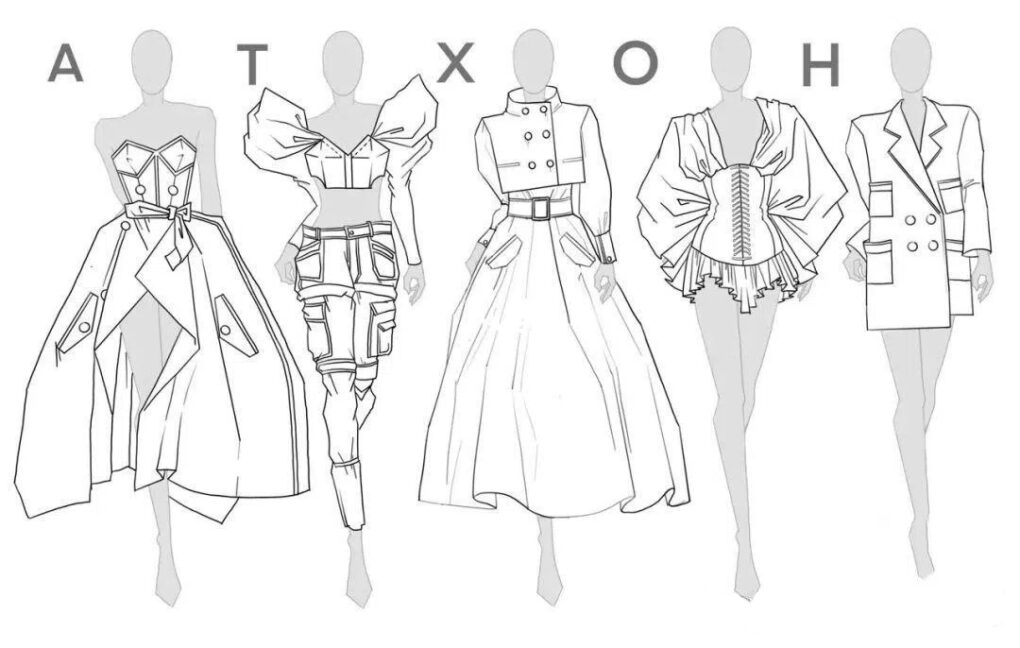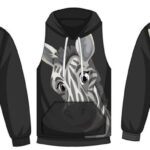Introduction
Understanding clothing silhouettes is a fundamental aspect of fashion knowledge that can greatly enhance one’s appreciation and expertise in the field. Silhouettes define the overall shape and form of a garment, creating the foundation for its style and impact. Whether you’re a fashion enthusiast, a budding designer, or someone who simply loves clothes, knowing how to distinguish different clothing silhouettes can enrich your perspective and inform your fashion choices.
Clothing silhouettes have a rich history, reflecting the cultural, social, and technological changes of their times. From the structured, corseted forms of the Victorian era to the loose, flowing lines of the 1920s flapper dresses, each silhouette tells a story about the period in which it was popular. These shapes are not just about aesthetics; they also reveal much about the values, lifestyles, and innovations of their respective eras.
Identifying different clothing silhouettes involves looking at key elements such as the cut, fit, and overall structure of a garment. It’s about noticing the lines and contours that define how a piece of clothing hangs on the body. This skill is invaluable for anyone involved in fashion, from designers and stylists to buyers and consumers. By recognizing these silhouettes, you can better appreciate the craftsmanship behind each garment and make more informed choices in your own wardrobe.
In this blog, we will delve into the histories and defining characteristics of some of the most common clothing silhouettes: T-shaped, O-shaped, S-shaped, A-shaped, H-shaped, and X-shaped. Each of these silhouettes has its own unique story and has seen periods of prominence throughout fashion history. We will explore the evolution of these shapes, their peak periods, and how they have influenced and been influenced by the world around them.
The Evolution of Clothing Silhouettes
The journey of clothing silhouettes is a fascinating reflection of human history, capturing the essence of various eras through the shapes and forms of garments. Each silhouette tells a unique story of societal norms, cultural values, and technological advancements, making the study of their evolution an insightful exploration into the past.
Early Beginnings
In ancient times, clothing was primarily functional, designed to protect the body from the elements. Early garments were often simple and draped, such as the tunics and togas of ancient Greece and Rome. These early silhouettes were straightforward, emphasizing comfort and practicality over form-fitting designs.
The Middle Ages to the Renaissance
As societies became more structured, so did clothing. The Middle Ages saw the introduction of more tailored garments, with fitted bodices and flowing skirts for women, and tunics and hose for men. This period marked the beginning of a more defined silhouette, with clothing starting to reflect social status and wealth.
The Renaissance brought about a dramatic change in fashion. With a renewed interest in art and beauty, clothing became more elaborate. The hourglass silhouette emerged, characterized by tight bodices and voluminous skirts for women, and padded doublets and hose for men. This era highlighted a desire for symmetry and proportion, drawing inspiration from classical ideals.
The 17th and 18th Centuries
The Baroque and Rococo periods of the 17th and 18th centuries saw clothing silhouettes become even more exaggerated. Women’s fashion was defined by wide skirts supported by panniers, tight corsets, and elaborate decorations, creating an opulent and theatrical silhouette. Men’s fashion also embraced embellishment, with fitted waistcoats, breeches, and coats adorned with intricate embroidery.

The Victorian Era
The Victorian era brought about significant changes in fashion silhouettes. The hourglass figure remained popular, but with new innovations such as the crinoline and later the bustle, which added volume to skirts in different ways. The corset became a staple, cinching the waist to create a dramatic contrast between the bust and hips. This period emphasized modesty and decorum, with clothing designed to reflect the wearer’s social status and adherence to societal norms.
The Early 20th Century
The turn of the 20th century ushered in a more relaxed approach to fashion. The Edwardian silhouette, with its S-shaped curve created by the “health corset,” gave way to the looser, more fluid lines of the 1920s flapper dress. This shift reflected the changing roles of women in society, as they gained more independence and began to participate more actively in public life. The dropped waistlines and shorter hemlines of the 1920s symbolized freedom and a break from the rigid structures of the past.
Mid-20th Century to Modern Day
The mid-20th century saw a return to more defined silhouettes. The 1940s and 1950s celebrated the hourglass figure once again, with nipped-in waists and full skirts becoming the hallmark of the era. Christian Dior’s “New Look” epitomized this silhouette, emphasizing femininity and elegance.
As fashion continued to evolve, the 1960s and 1970s introduced more diverse and experimental silhouettes. The shift dress, A-line skirts, and the emergence of unisex fashion reflected the cultural revolutions of the time. The 1980s brought bold, oversized silhouettes with power suits and shoulder pads, symbolizing women’s growing presence in the workforce.
In contemporary fashion, silhouettes are more varied than ever. Designers draw inspiration from past eras while pushing the boundaries with innovative materials and techniques. Today, the focus is on individuality and personal expression, with silhouettes ranging from body-hugging to oversized, and everything in between.
Cultural and Technological Influences
Throughout history, clothing silhouettes have been shaped by cultural and technological changes. Advances in textile production, the invention of the sewing machine, and global trade have all played crucial roles in the evolution of fashion. Cultural movements, such as the feminist and civil rights movements, have also influenced how clothing is designed and worn, reflecting broader societal shifts.
Identifying Clothing Silhouettes
Understanding and identifying clothing silhouettes is a crucial skill in the world of fashion. Silhouettes define the overall shape and outline of a garment, playing a key role in how it drapes, fits, and looks on the body. By recognizing these silhouettes, one can better appreciate the design and craftsmanship of fashion pieces, and make more informed choices when selecting or designing clothing.

Key Elements of Clothing Silhouettes
To identify different clothing silhouettes, it is essential to focus on the garment’s cut, fit, and overall structure. Here are the main elements to consider:
- Cut: The cut of a garment refers to how it is shaped and constructed. This includes the way the fabric is sewn together, the placement of seams, and the overall pattern of the garment. The cut determines whether a piece is tight-fitting, loose, or somewhere in between.
- Fit: Fit describes how the garment conforms to the body. It ranges from body-hugging fits that accentuate the wearer’s shape to loose, flowing fits that create a more relaxed silhouette. The fit of a garment significantly influences its silhouette.
- Structure: The structure of a garment involves its design elements, such as darts, pleats, and gathers, as well as the type of fabric used. Structured garments often have a more defined silhouette, while unstructured ones tend to have a softer, more fluid shape.
Visual Cues and Garment Structure
When identifying silhouettes, visual cues are paramount. Here are some practical tips for recognizing different silhouettes:
- Lines and Contours: Observe the lines and contours of the garment. Are they straight and angular, or soft and curved? Do they create a boxy shape or an hourglass figure?
- Proportions: Pay attention to the proportions of the garment. Is the emphasis on the shoulders, waist, or hips? How does the length of the garment affect its overall shape?
- Fabric and Texture: The type of fabric and its texture can influence the silhouette. Stiffer fabrics tend to create more structured shapes, while softer fabrics allow for more fluid and relaxed silhouettes.
- Details and Embellishments: Details such as pleats, ruffles, and gathers can add volume and shape to a garment. Embellishments like belts and waistbands can alter the perceived silhouette by cinching in certain areas.

Practical Tips for Identifying Silhouettes
Here are some additional practical tips to help you identify different clothing silhouettes:
- Analyze the Garment’s Outline: Stand back and look at the overall outline of the garment. This can give you a clear idea of its silhouette. Squinting can help you focus on the shape rather than the details.
- Consider the Garment’s Purpose: Think about the garment’s intended purpose and how it is meant to be worn. Formal attire often has more structured silhouettes, while casual wear tends to have relaxed shapes.
- Try the Garment On: If possible, try the garment on or visualize it on a mannequin. Seeing how it interacts with the body can provide valuable insights into its silhouette.
- Compare with Known Silhouettes: Compare the garment with known silhouettes, such as A-line, H-line, or X-line. Identifying similarities and differences can help you classify the silhouette accurately.
Importance of Identifying Clothing Silhouettes
Understanding clothing silhouettes is essential for various reasons:
- Enhanced Fashion Knowledge: Recognizing different silhouettes enhances your overall fashion knowledge, allowing you to appreciate the nuances of design and construction.
- Improved Wardrobe Choices: Knowing which silhouettes flatter your body shape can help you make better wardrobe choices, ensuring you look and feel your best.
- Informed Design Decisions: For designers and fashion professionals, understanding silhouettes is crucial for creating garments that achieve the desired aesthetic and functionality.
- Historical and Cultural Appreciation: Identifying silhouettes allows you to appreciate the historical and cultural significance of fashion trends, deepening your connection to the art of fashion.
By mastering the skill of identifying clothing silhouettes, you open up a world of possibilities in fashion appreciation and design. Whether you’re selecting outfits for yourself or creating new fashion pieces, understanding silhouettes is a valuable tool in your fashion arsenal.
Common Clothing Silhouettes and Their Histories
Clothing silhouettes are the foundation of fashion design, shaping the way garments fit and flow on the body. Each silhouette has its own unique history and characteristics, reflecting the cultural and social trends of the time. In this section, we will explore six common clothing silhouettes: T-shaped, O-shaped, S-shaped, A-shaped, H-shaped, and X-shaped. We will delve into their historical evolution, key features, and peak periods.
T-Shaped Silhouette
Description and Features: The T-shaped silhouette is characterized by its straight, boxy lines, resembling the letter “T.” It typically features broad shoulders and a straight, loose fit that falls away from the body.
Historical Evolution: The T-shaped silhouette gained popularity in the early 20th century, particularly during the 1920s with the advent of flapper dresses. These dresses had a loose, straight cut that provided freedom of movement and a modern look, breaking away from the restrictive corsets of the previous era.
Peak Periods: The T-shaped silhouette saw a resurgence in the 1960s with the rise of mod fashion. Iconic designers like Mary Quant popularized the shift dress, a simple, straight-cut dress that epitomized the T-shaped silhouette.
O-Shaped Silhouette
Description and Features: The O-shaped silhouette features a rounded, voluminous shape, often achieved through the use of draping and gathering. This silhouette creates a soft, cocoon-like effect around the body.
Historical Evolution: The O-shaped silhouette emerged in the mid-20th century, influenced by the work of designers like Cristóbal Balenciaga. Balenciaga’s innovative designs in the 1950s and 1960s introduced rounded shapes and voluminous forms, moving away from the fitted styles of earlier decades.
Peak Periods: The O-shaped silhouette reached its peak in the 1980s with the popularity of oversized, cocoon coats and loose-fitting garments. This period embraced bold, exaggerated shapes that made a strong fashion statement.
S-Shaped Silhouette
Description and Features: The S-shaped silhouette is defined by its curvaceous, serpentine lines, often achieved through corsetry and strategic tailoring. This silhouette emphasizes an exaggerated bust and hips, with a narrow, cinched waist.

Historical Evolution: The S-shaped silhouette became prominent during the Edwardian era (early 1900s), with the introduction of the “health corset.” This corset pushed the hips back and the chest forward, creating an S-curve that was considered the ideal feminine figure of the time.
Peak Periods: The S-shaped silhouette remained popular through the early 20th century, influencing fashion until World War I. It reflected the societal standards of beauty and femininity during this period.
A-Shaped Silhouette
Description and Features: The A-shaped silhouette features a narrow top that gradually widens towards the hem, resembling the letter “A.” This silhouette is often seen in dresses and skirts that flare out from the waist or hips.
Historical Evolution: The A-shaped silhouette gained prominence in the 1950s, popularized by designers like Christian Dior. Dior’s “New Look” emphasized a small waist and full skirt, creating a flattering A-line shape that celebrated femininity and elegance.

Peak Periods: The A-shaped silhouette continued to be popular throughout the 1960s with the introduction of the A-line mini dress. This style became a staple of mod fashion and remains a timeless favorite in contemporary fashion.
H-Shaped Silhouette
Description and Features: The H-shaped silhouette, also known as the rectangle or column silhouette, is characterized by its straight, vertical lines. It features little to no waist definition and a uniform width from shoulders to hem.
Historical Evolution: The H-shaped silhouette emerged in the 1920s with the rise of the flapper dress. This silhouette rejected the hourglass figure of the previous era, favoring a more androgynous, boyish look.
Peak Periods: The H-shaped silhouette saw a resurgence in the 1990s with the popularity of minimalistic fashion. Designers like Calvin Klein embraced clean, straight lines and simple designs that defined the H-shaped silhouette.
X-Shaped Silhouette
Description and Features: The X-shaped silhouette, or hourglass silhouette, is characterized by a fitted bodice, defined waist, and flared hips. It creates a balanced, curvaceous shape that accentuates the natural curves of the body.

Historical Evolution: The X-shaped silhouette has been a recurring favorite throughout fashion history. It gained significant popularity during the Victorian era, with tight corsets and voluminous skirts creating an exaggerated hourglass figure.
Peak Periods: The X-shaped silhouette saw a major revival in the 1950s with Dior’s “New Look.” This silhouette emphasized a small waist and full skirt, celebrating the hourglass figure. It remains a classic and enduring silhouette in modern fashion.
Other Notable Clothing Silhouettes
In addition to the commonly recognized silhouettes such as T-shaped, O-shaped, S-shaped, A-shaped, H-shaped, and X-shaped, the fashion world boasts a variety of other intriguing silhouettes that have made their mark. These silhouettes often emerge from unique cultural movements, technological advancements, and designers’ innovative visions. Understanding these additional silhouettes provides a deeper insight into the diversity and creativity within fashion design.
Y-Shaped Silhouette
Description and Features: The Y-shaped silhouette is characterized by broad shoulders that taper down to a narrower hemline. This silhouette creates a strong, structured upper body with a sleek lower half, resembling the letter “Y.”
Historical Evolution: The Y-shaped silhouette gained popularity in the 1980s, an era known for its bold and exaggerated fashion choices. Power suits with padded shoulders became iconic during this time, symbolizing strength and authority, especially in the context of women’s growing presence in the workforce.
Peak Periods: The Y-shaped silhouette saw its peak during the 1980s, heavily influenced by designers like Giorgio Armani and Thierry Mugler. These designers embraced the powerful and imposing aesthetic that the Y-shape offered, making it a defining feature of the decade.
V-Shaped Silhouette
Description and Features: The V-shaped silhouette features a narrow top that dramatically widens at the hem, creating an inverted triangle shape. This silhouette often emphasizes the lower half of the body, with flowing skirts or wide-legged pants.
Historical Evolution: The V-shaped silhouette emerged as a significant trend in the 1970s, coinciding with the bohemian and hippie movements. Maxi skirts and bell-bottoms were popular, highlighting the wide, flowing lines characteristic of the V-shape.
Peak Periods: The V-shaped silhouette was at its height during the 1970s, with fashion icons like Jane Birkin and Stevie Nicks epitomizing the free-spirited and relaxed style. The silhouette represented a departure from the structured and fitted styles of previous decades.
I-Shaped Silhouette
Description and Features: The I-shaped silhouette, also known as the column or straight silhouette, is characterized by its long, narrow, and straight lines. This silhouette provides a sleek, elongated appearance without emphasizing the waist or curves.
Historical Evolution: The I-shaped silhouette became prominent in the 1960s with the rise of mod fashion. Designers like André Courrèges and Mary Quant introduced simple, geometric designs that embraced the straight, clean lines of the I-shape.
Peak Periods: The I-shaped silhouette reached its peak in the 1960s, capturing the minimalist and futuristic spirit of the decade. Shift dresses, straight-cut coats, and streamlined suits were all part of this silhouette’s iconic look.
U-Shaped Silhouette
Description and Features: The U-shaped silhouette features a rounded, voluminous upper body that tapers to a narrower hem, creating a shape similar to the letter “U.” This silhouette often involves oversized tops or coats paired with fitted bottoms.
Historical Evolution: The U-shaped silhouette gained traction in the late 20th and early 21st centuries, particularly within avant-garde and experimental fashion circles. Designers like Yohji Yamamoto and Rei Kawakubo of Comme des Garçons have explored this silhouette, pushing the boundaries of traditional fashion.
Peak Periods: The U-shaped silhouette is associated with contemporary fashion movements, often seen on runways and in high fashion editorial spreads. It represents a departure from conventional forms, embracing volume and asymmetry.
W-Shaped Silhouette
Description and Features: The W-shaped silhouette features a flared, dramatic upper body and lower body with a cinched or fitted waist, creating a shape reminiscent of the letter “W.” This silhouette emphasizes both the shoulders and the hips.
Historical Evolution: The W-shaped silhouette has been explored by various designers throughout the 20th and 21st centuries, particularly in haute couture. It combines elements of the hourglass and inverted triangle silhouettes to create a striking, balanced look.
Peak Periods: The W-shaped silhouette appears in high fashion and couture collections, often used to create theatrical and statement-making pieces. Designers like Alexander McQueen and Vivienne Westwood have utilized this silhouette to craft bold, avant-garde designs.
Conclusion
The study of clothing silhouettes offers a fascinating glimpse into the evolution of fashion and its interplay with cultural, social, and technological changes. By understanding these silhouettes, we can appreciate the artistry and craftsmanship that goes into creating garments, as well as the historical contexts that have shaped their development.
In conclusion, clothing silhouettes are much more than just shapes and forms; they are a reflection of the times, a testament to human creativity, and a vital element of personal expression. By understanding their histories, recognizing their features, and appreciating their diversity, we enrich our connection to fashion and its enduring legacy.







